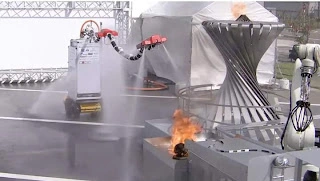The dragon is not only a mythical creature but also a part of the art, literature and religion of various cultures. The Chinese dragon is usually imagined as a creature with a long snake-like body and four legs, which is the god of natural energy, water, rain and harvest.
In Western culture, dragons are depicted as fire-breathing winged creatures. In ancient Greece, Rome, and medieval European mythology, the dragon is a huge and terrifying flying creature. Japanese dragons usually have three legs and are depicted more simply. The common imagination of people today is that dragons can shoot fire from their mouths and burn everything.
Researchers have sought to debunk this myth. They have created a dragon robot that, instead of setting fire, extinguishes fire by spraying water from its mouth.
Based on this beneficial concept of dragons, scientists have developed a robot named “Dragon Firefighter”, which has been undergoing experiments in Japan for several years.
Last year in December (2023), a research paper titled ‘Development of a remotely controllable 4 m long aerial-hose-type firefighting robot’ was published in the journal Frontiers Robotics and AI, where the successful demonstration of a prototype of the Dragon Firefighter was described.
The robot is named “Dragon Firefighter” or “Flying Dragon”. It is actually a flying hosepipe, which will assist firefighters in dangerous situations. They said, “When a fire breaks out, firefighters need to quickly put out the fire and stop the spread of damage as well as prevent further disasters caused by it. We proposed the concept of a Dragon Firefighter (DFF), a flying-hose-type fire-fighting robot.”
The paper focuses on the following topics:
- Installing remotely controllable mobile bases;
- redesigning the water channel (nozzle outlet shape) to get enough thrust to fly with a fire engine;
- Development of nozzle units with a larger moving range (one and a half times larger than conventional nozzles) in addition to waterproofing techniques to improve system reliability, and
- Redesigned a passive damping mechanism to ensure better stability.
The design of the robot is made in open science method, that is, any researcher in the world can use this design to create their own dragon firefighter robot.
The robot’s designers hope that within the next decade, this firefighter robot will become fully suitable for use in firefighting.
“We present here a four-meter long prototype, which is a remote-controlled flying firehose robot. It is designed to safely and efficiently extinguish building fires by providing direct resistance to the source of the fire,” said one of the project’s team leaders, Dr. Yuchi Mango. Ambe is an associate professor at Osaka University.
In 2016, a research team in Professor Satoshi Tadokoro’s laboratory at Tohoku University began working on a similar flying robot. Since then 11 researchers and students have been involved in working on this project.
During and before working on this robot, they contacted the Japanese fire brigade at various times to try to get the data and techniques they needed. Based on that, this robot is equipped with various facilities.
Jet Engine Driven Dragon
Dragon Firefighter firehose or sprinkler pipe can fly 2 meters above the ground. It has 8 controlled jets in the middle and front, capable of spraying water.
The pipe can change its shape and rotate itself towards the flame if needed. The control unit is housed in a wheeled box behind the pipe for control. This box is connected to the fire truck by a supply tube. The fire truck can hold up to 14,000 liters of water.
A sprinkler nozzle can eject 6.6 liters of water per second at a pressure of one mega pascal. At the top of the hosepipe there is a normal camera and a thermal imaging camera. Their job is to find the source of the fire.
Successful Exhibition At World Robot Summit In Fukushima
The world first got to know about the Dragon Firefighter at the opening ceremony of the Fukushima World Robot Summit 2020 (WRS2020) held in Japan in September 2021. There, this robot was able to successfully put out the flames.
This fire was also created by another robot 4 meters away from the Dragon Firefighter. In addition to the design of the firefighter robot, the present study reviews the results obtained from the first demonstration in 2021. The researchers also informed the journalists about what other improvements have already been made.
Associate Professor of Akita Prefectural University. Yu Yamauchi and another co-author commented, “Since the exhibition at WRS 2020, we have been constantly working on the development of this dragon robot, and we have learned many new things.”
“As we’ve seen the passive dampening approach initially thought to deal with Dragon Firefight vibration is not practical. Because it takes a lot of time for the dragon to fly. We have also seen that the heat generated by the fire can destroy the plastic covering water hose pipes and electrical cables.”
Other tasks described in the research include improving the waterproofing system, creating nozzle units that can eject water with greater force, and creating better channeling systems to channel the water properly. Besides, some more necessary developments are being worked on.
Wait Another 10 Years
“We have calculated that our robot will need another 10 years to be ready to deal with real fire incidents,” Ambe said.
“Our first challenge is to make it capable of extinguishing fire from a distance of 10 meters. In addition, one of the main goals of our work is to figure out how cutting-edge firefighting technologies can be applied in line with the unique capabilities of robots.”
What If The Robot Starts Working?
Firefighting is a dangerous and difficult job. Firefighters risk their lives to do this every day. As technology advances, the idea of using robots to put out fires is becoming increasingly popular. Let’s discuss how this technology will bring significant changes in fire fighting.
Firefighting using robots will greatly reduce the risk of human casualties. A hazardous environment will not require human presence then. The risks faced by firefighters due to smoke and extreme temperatures will be solved. It will be possible to control the robots quickly, thereby extinguishing the fire in the fastest possible time.
Robots can be programmed to spray water at specific locations, making firefighting more effective. Robots can be easily deployed in different locations, which will ensure quick response.
In the long run, using robots to put out fires could be less costly than humans. Robots can be controlled more carefully, resulting in less property damage. And fighting fires using robots will also pollute the environment less.


